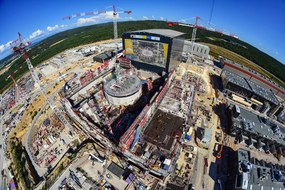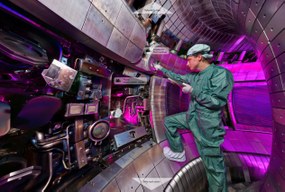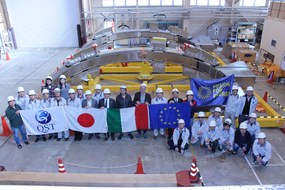Innovation: In ENEA’s magazine ‘l’energia delle stelle’ (the energy of stars) and the Chinese road map
21/11/2019
Get the latest issue of the magazine ‘Energia Ambiente e Innovazione’ via the ENEA site and App.
 ENEA’s magazine, “Energia, Ambiente e Innovazione” is available online. It’s dedicated to “the energy of stars” − the great challenge to produce clean, sustainable and waste-free energy that brings together the major research institutions and instances of true excellence among entrepreneurs Europe-wide. In addition to online access via the ENEA website, the ENEA magazine now can also be accessed via the free “EAI - ENEA Magazine” app for smartphones and tablets (Android and iOS).
ENEA’s magazine, “Energia, Ambiente e Innovazione” is available online. It’s dedicated to “the energy of stars” − the great challenge to produce clean, sustainable and waste-free energy that brings together the major research institutions and instances of true excellence among entrepreneurs Europe-wide. In addition to online access via the ENEA website, the ENEA magazine now can also be accessed via the free “EAI - ENEA Magazine” app for smartphones and tablets (Android and iOS).
 In this issue, the magazine analyses the criticalities, prospects and scientific repercussions of nuclear fusion, with major players in the sector, such as Ambrogio Fasoli, President of the European EUROfusion consortium for the development of nuclear fusion; Sergio Orlandi, Engineering and Plant director of the ITER Project; Elena Righi Steele, Head of the Euratom Research Unit of the EU Research and Innovation Directorate General; Johannes Schwemmer, Director of the Fusion for Energy consortium, and Professor Jiangang Li, the deputy director of the Chinese Academy of Sciences, who outlines China’s ambitious roadmap toward commissioning the first real fusion power plant between 2050 and 2060 at the latest. The Italians include the presidents of the consortia CREATE (Vincenzo Coccorese) and RFX (Francesco Gnesotto); the Director of the Institute for Plasma Science and Technology (ISTP), Maurizio Lontano; Piero Martin, Professor of Experimental Physics and member of the Executive Board of the DTT project; and Raffaele Martone, Professor at the University of Campania “L. Vanvitelli”.
In this issue, the magazine analyses the criticalities, prospects and scientific repercussions of nuclear fusion, with major players in the sector, such as Ambrogio Fasoli, President of the European EUROfusion consortium for the development of nuclear fusion; Sergio Orlandi, Engineering and Plant director of the ITER Project; Elena Righi Steele, Head of the Euratom Research Unit of the EU Research and Innovation Directorate General; Johannes Schwemmer, Director of the Fusion for Energy consortium, and Professor Jiangang Li, the deputy director of the Chinese Academy of Sciences, who outlines China’s ambitious roadmap toward commissioning the first real fusion power plant between 2050 and 2060 at the latest. The Italians include the presidents of the consortia CREATE (Vincenzo Coccorese) and RFX (Francesco Gnesotto); the Director of the Institute for Plasma Science and Technology (ISTP), Maurizio Lontano; Piero Martin, Professor of Experimental Physics and member of the Executive Board of the DTT project; and Raffaele Martone, Professor at the University of Campania “L. Vanvitelli”.
 In the editorial, the President of ENEA, Federico Testa, highlights the fundamental difference between fusion and fission and underlines how the first one can “revolutionize energy scenarios because it blends science, innovation, the struggle against climate change, development and industrial competitiveness in a winning equation”. EIB Vice-President Dario Scannapieco is convinced that “more should be dedicated to ensuring the future of the planet, focusing responsibly on the long term, without the angst that accompanies the very short-term viewpoint and all too frequently conditions decisions on allocation of financial resources”.
In the editorial, the President of ENEA, Federico Testa, highlights the fundamental difference between fusion and fission and underlines how the first one can “revolutionize energy scenarios because it blends science, innovation, the struggle against climate change, development and industrial competitiveness in a winning equation”. EIB Vice-President Dario Scannapieco is convinced that “more should be dedicated to ensuring the future of the planet, focusing responsibly on the long term, without the angst that accompanies the very short-term viewpoint and all too frequently conditions decisions on allocation of financial resources”.
 Ample space is given over to instances of Italian excellence, as protagonists in large international fusion projects: companies of varying origin and ‘careers’ such as Angelantoni Test Technologies, Ansaldo Nucleare, ASG Superconductors, CECOM, Consorzio ICAS Delta Ti, Mangiarotti, OCEM Energy Technology, SIMIC, Walter Tosto and Zanon Tratos, plus interviews with Gino Cocchi (OCEM), Marianna Ginola (SIMIC), Davide Malacalza (ASG Superconductors) and Luca Tosto (Walter Tosto). Also most worthy of note are the large ITER Broader Approach projects and developments in Italy with MITICA and the upcoming DTT project. The work on data relative to corporate economic and social footprints has been entrusted to ENEA’s Paola Batistoni as well as Gloria Puliga and Raffaella Manzini of the Carlo Cattaneo University (LIUC) in the municipality of Castellanza. Within the ambit of a pilot study on a group of Italian companies winning contracts for ITER, marked improvements were noted in regard to technological and organizational innovation, development of new technical skills (93%), new processes (73%), products or patents (14%), and new recruitment figures.
Ample space is given over to instances of Italian excellence, as protagonists in large international fusion projects: companies of varying origin and ‘careers’ such as Angelantoni Test Technologies, Ansaldo Nucleare, ASG Superconductors, CECOM, Consorzio ICAS Delta Ti, Mangiarotti, OCEM Energy Technology, SIMIC, Walter Tosto and Zanon Tratos, plus interviews with Gino Cocchi (OCEM), Marianna Ginola (SIMIC), Davide Malacalza (ASG Superconductors) and Luca Tosto (Walter Tosto). Also most worthy of note are the large ITER Broader Approach projects and developments in Italy with MITICA and the upcoming DTT project. The work on data relative to corporate economic and social footprints has been entrusted to ENEA’s Paola Batistoni as well as Gloria Puliga and Raffaella Manzini of the Carlo Cattaneo University (LIUC) in the municipality of Castellanza. Within the ambit of a pilot study on a group of Italian companies winning contracts for ITER, marked improvements were noted in regard to technological and organizational innovation, development of new technical skills (93%), new processes (73%), products or patents (14%), and new recruitment figures.
 The history of, and prospects for, fusion are illustrated by Aldo Pizzuto, Giuseppe Mazzitelli, Luigi Morici, Mariano Tarantino, Lori Gabellieri and Gregorio Vlad of the ENEA Nuclear Safety and Security Department. The contribution of the ENEA supercomputers is handled by Silvio Migliori, Francesco Iannone and Massimo Celino of the ENEA IT and ICT systems development division (Divisione ENEA per lo Sviluppo di sistemi per informatica e ICT). The scenario analyses, which are entrusted to Marco Franza of the Brussels Office, dwell on the importance of the EURATOM treaty. Gianmaria Sannino, heading the Climate Modeling and Impacts Laboratory, addresses the increasingly alarming climate-energy link impacted by fossil fuels. Chiara Martini, an expert on issues relating to energy poverty, explores this problem area vis-à-vis technological innovation.
The history of, and prospects for, fusion are illustrated by Aldo Pizzuto, Giuseppe Mazzitelli, Luigi Morici, Mariano Tarantino, Lori Gabellieri and Gregorio Vlad of the ENEA Nuclear Safety and Security Department. The contribution of the ENEA supercomputers is handled by Silvio Migliori, Francesco Iannone and Massimo Celino of the ENEA IT and ICT systems development division (Divisione ENEA per lo Sviluppo di sistemi per informatica e ICT). The scenario analyses, which are entrusted to Marco Franza of the Brussels Office, dwell on the importance of the EURATOM treaty. Gianmaria Sannino, heading the Climate Modeling and Impacts Laboratory, addresses the increasingly alarming climate-energy link impacted by fossil fuels. Chiara Martini, an expert on issues relating to energy poverty, explores this problem area vis-à-vis technological innovation.
